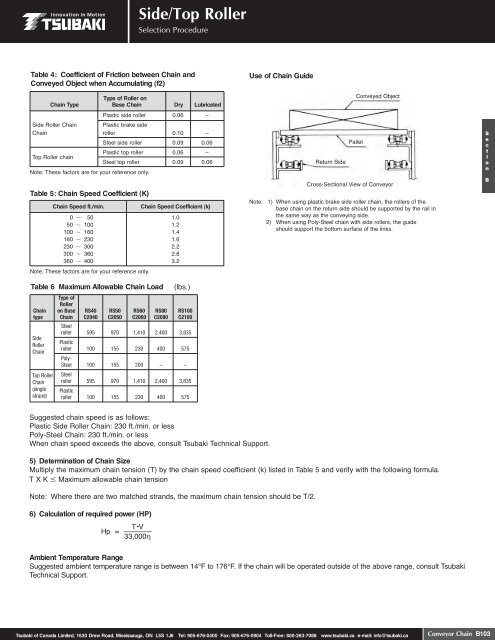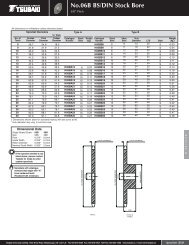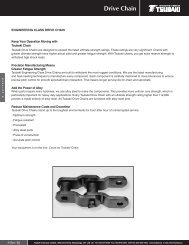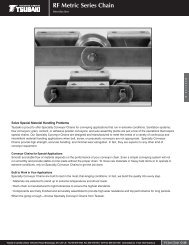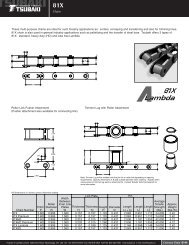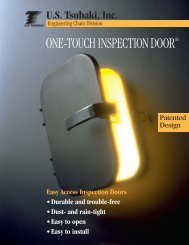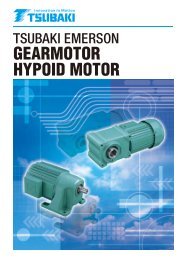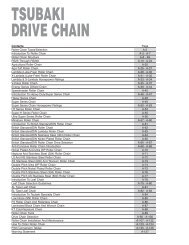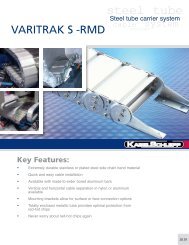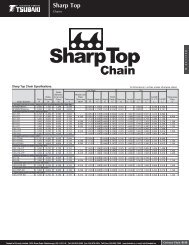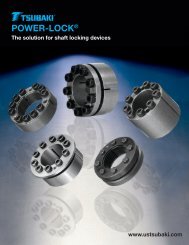Conveyor Chain - Tsubaki
Conveyor Chain - Tsubaki
Conveyor Chain - Tsubaki
- No tags were found...
You also want an ePaper? Increase the reach of your titles
YUMPU automatically turns print PDFs into web optimized ePapers that Google loves.
Side/Top RollerSelection ProcedureTable 4: Coefficient of Friction between <strong>Chain</strong> andConveyed Object when Accumulating (f2)Use of <strong>Chain</strong> GuideType of Roller on<strong>Chain</strong> Type Base <strong>Chain</strong> Dry LubricatedConveyed ObjectPlastic side roller 0.06 –Side Roller <strong>Chain</strong> Plastic brake side<strong>Chain</strong> roller 0.10 –Steel side roller 0.09 0.06Top Roller chainPlastic top roller 0.06 –Steel top roller 0.09 0.06Note: These factors are for your reference only.Table 5: <strong>Chain</strong> Speed Coefficient (K)<strong>Chain</strong> Speed ft./min.Note: These factors are for your reference only.<strong>Chain</strong> Speed Coefficient (k)0 50 1.050 100 1.2100 160 1.4160 230 1.6230 300 2.2300 360 2.8360 400 3.2Return SidePalletCross-Sectional View of <strong>Conveyor</strong>Note: 1) When using plastic brake side roller chain, the rollers of thebase chain on the return side should be supported by the rail inthe same way as the conveying side.2) When using Poly-Steel chain with side rollers, the guideshould support the bottom surface of the links.SectionBTable 6 Maximum Allowable <strong>Chain</strong> Load(lbs.)Type ofRoller<strong>Chain</strong> on Base RS40 RS50 RS60 RS80 RS100type <strong>Chain</strong> C2040 C2050 C2060 C2080 C2100SideRoller<strong>Chain</strong>Top Roller<strong>Chain</strong>(singlestrand)Steelroller 595 970 1,410 2,400 3,835Plasticroller 100 155 230 400 575Poly-Steel 100 155 200 – –Steelroller 595 970 1,410 2,400 3,835Plasticroller 100 155 230 400 575Suggested chain speed is as follows:Plastic Side Roller <strong>Chain</strong>: 230 ft./min. or lessPoly-Steel <strong>Chain</strong>: 230 ft./min. or lessWhen chain speed exceeds the above, consult <strong>Tsubaki</strong> Technical Support.5) Determination of <strong>Chain</strong> SizeMultiply the maximum chain tension (T) by the chain speed coefficient (k) listed in Table 5 and verify with the following formula.T X K Maximum allowable chain tensionNote: Where there are two matched strands, the maximum chain tension should be T/2.6) Calculation of required power (HP)T•VHp = –––––––33,000ηAmbient Temperature RangeSuggested ambient temperature range is between 14°F to 176°F. If the chain will be operated outside of the above range, consult <strong>Tsubaki</strong>Technical Support.<strong>Tsubaki</strong> of Canada Limited, 1630 Drew Road, Mississauga, ON L5S 1J6 Tel: 905-676-0400 Fax: 905-676-0904 Toll-Free: 800-263-7088 www.tsubaki.ca e-mail: info@tsubaki.ca<strong>Conveyor</strong> <strong>Chain</strong> B103


